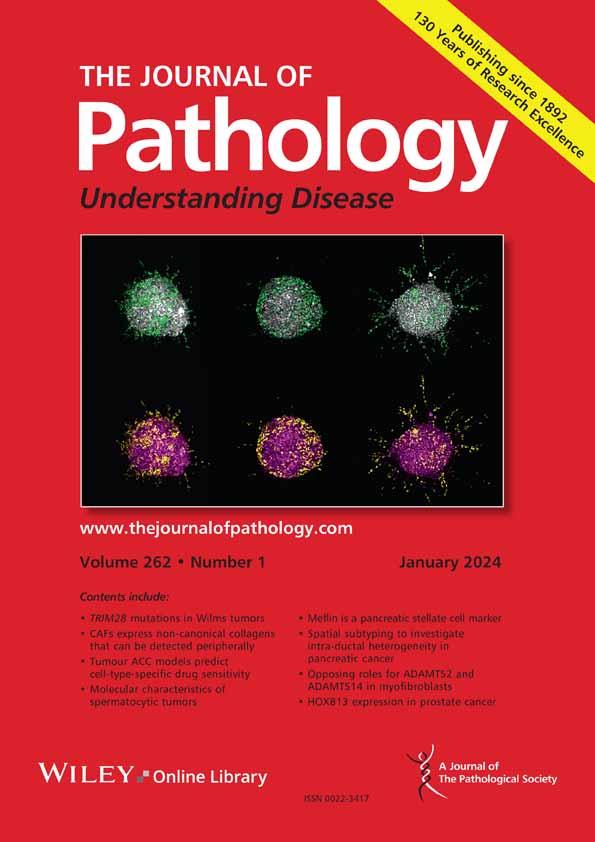下载PDF
{"title":"Aberrant TERT expression: linking chronic inflammation to hepatocellular carcinoma†","authors":"Rui Dong, Gregoire Najjar, Cagatay Günes, André Lechel","doi":"10.1002/path.6421","DOIUrl":null,"url":null,"abstract":"<p>Telomerase reverse transcriptase (TERT), the catalytic enzyme component of telomerase, plays multiple roles in cellular biology. Its canonical function is primarily associated with telomere maintenance and genomic stability. In addition, several studies revealed critical non-canonical extra-telomeric functions of TERT in various cellular processes, including cell proliferation and survival, DNA damage response, transcription, signal transduction, and metabolic regulation, both in normal and in cancer cells. Notably, TERT is aberrantly upregulated in more than 80% of hepatocellular carcinoma (HCC) cases, making it an important target in liver cancer research. However, due to the diversity and complexity of TERT's functions <i>in vivo</i>, the precise mechanisms by which TERT contributes to the initiation and progression of HCC remain unclear. A recent study published in <i>The Journal of Pathology</i> using the <i>Alb-Cre;Tert</i>Tg mouse model and clinical HCC samples addresses the role of TERT in hepatocarcinogenesis. The study demonstrates that TERT promotes cell cycle progression and hepatocarcinogenesis by enhancing NF-κB promoter activity and facilitating the ubiquitination of p21. Notably, absence of functional p53 accelerates liver tumor development in TERT transgenic mice. These findings further underscore the critical role of TERT in inflammation-driven hepatocarcinogenesis and provide new insights into its underlying mechanisms. © 2025 The Author(s). <i>The Journal of Pathology</i> published by John Wiley & Sons Ltd on behalf of The Pathological Society of Great Britain and Ireland.</p>","PeriodicalId":232,"journal":{"name":"The Journal of Pathology","volume":"266 2","pages":"130-133"},"PeriodicalIF":5.2000,"publicationDate":"2025-04-11","publicationTypes":"Journal Article","fieldsOfStudy":null,"isOpenAccess":false,"openAccessPdf":"https://onlinelibrary.wiley.com/doi/epdf/10.1002/path.6421","citationCount":"0","resultStr":null,"platform":"Semanticscholar","paperid":null,"PeriodicalName":"The Journal of Pathology","FirstCategoryId":"3","ListUrlMain":"https://pathsocjournals.onlinelibrary.wiley.com/doi/10.1002/path.6421","RegionNum":2,"RegionCategory":"医学","ArticlePicture":[],"TitleCN":null,"AbstractTextCN":null,"PMCID":null,"EPubDate":"","PubModel":"","JCR":"Q1","JCRName":"ONCOLOGY","Score":null,"Total":0}
引用次数: 0
引用
批量引用
Abstract
Telomerase reverse transcriptase (TERT), the catalytic enzyme component of telomerase, plays multiple roles in cellular biology. Its canonical function is primarily associated with telomere maintenance and genomic stability. In addition, several studies revealed critical non-canonical extra-telomeric functions of TERT in various cellular processes, including cell proliferation and survival, DNA damage response, transcription, signal transduction, and metabolic regulation, both in normal and in cancer cells. Notably, TERT is aberrantly upregulated in more than 80% of hepatocellular carcinoma (HCC) cases, making it an important target in liver cancer research. However, due to the diversity and complexity of TERT's functions in vivo , the precise mechanisms by which TERT contributes to the initiation and progression of HCC remain unclear. A recent study published in The Journal of Pathology using the Alb-Cre;Tert Tg mouse model and clinical HCC samples addresses the role of TERT in hepatocarcinogenesis. The study demonstrates that TERT promotes cell cycle progression and hepatocarcinogenesis by enhancing NF-κB promoter activity and facilitating the ubiquitination of p21. Notably, absence of functional p53 accelerates liver tumor development in TERT transgenic mice. These findings further underscore the critical role of TERT in inflammation-driven hepatocarcinogenesis and provide new insights into its underlying mechanisms. © 2025 The Author(s). The Journal of Pathology published by John Wiley & Sons Ltd on behalf of The Pathological Society of Great Britain and Ireland.
TERT表达异常:慢性炎症与肝细胞癌之间的联系
端粒酶逆转录酶(TERT)是端粒酶的催化酶组分,在细胞生物学中起着多种作用。其典型功能主要与端粒维持和基因组稳定性有关。此外,一些研究揭示了TERT在各种细胞过程中的关键非规范端粒功能,包括细胞增殖和存活、DNA损伤反应、转录、信号转导和代谢调节,在正常细胞和癌细胞中都是如此。值得注意的是,TERT在超过80%的肝细胞癌(HCC)病例中异常上调,使其成为肝癌研究的重要靶点。然而,由于TERT在体内功能的多样性和复杂性,TERT促进HCC发生和发展的确切机制尚不清楚。最近发表在《病理学杂志》上的一项研究利用Alb-Cre;TertTg小鼠模型和临床HCC样本探讨了TERT在肝癌发生中的作用。研究表明,TERT通过增强NF-κB启动子活性和促进p21泛素化,促进细胞周期进程和肝癌发生。值得注意的是,在TERT转基因小鼠中,缺乏功能性p53会加速肝脏肿瘤的发展。这些发现进一步强调了TERT在炎症驱动的肝癌发生中的关键作用,并为其潜在机制提供了新的见解。©2025作者。《病理学杂志》由约翰·威利出版;儿子有限公司代表大不列颠及爱尔兰病理学会。
本文章由计算机程序翻译,如有差异,请以英文原文为准。






 求助内容:
求助内容: 应助结果提醒方式:
应助结果提醒方式:


